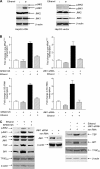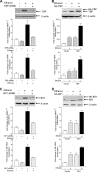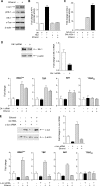Alcohol induces RNA polymerase III-dependent transcription through c-Jun by co-regulating TATA-binding protein (TBP) and Brf1 expression
- PMID: 21106530
- PMCID: PMC3024733
- DOI: 10.1074/jbc.M110.192955
Alcohol induces RNA polymerase III-dependent transcription through c-Jun by co-regulating TATA-binding protein (TBP) and Brf1 expression
Abstract
Chronic alcohol consumption is associated with steatohepatitis and cirrhosis, enhancing the risk for hepatocellular carcinoma. RNA polymerase (pol) III transcribes a variety of small, untranslated RNAs, including tRNAs and 5S rRNAs, which determine the biosynthetic capacity of cells. Increased RNA pol III-dependent transcription, observed in transformed cells and human tumors, is required for oncogenic transformation. Given that alcohol consumption increases risk for liver cancer, we examined whether alcohol regulates this class of genes. Ethanol induces RNA pol III-dependent transcription in both HepG2 cells and primary mouse hepatocytes in a manner that requires ethanol metabolism and the activation of JNK1. This regulatory event is mediated, at least in part, through the ability of ethanol to induce expression of the TFIIIB components, Brf1, and the TATA-binding protein (TBP). Induction of TBP, Brf1, and RNA pol III-dependent gene expression is driven by enhanced c-Jun expression. Ethanol promotes a marked increase in the direct recruitment of c-Jun to TBP, Brf1, and tRNA gene promoters. Chronic alcohol administration in mice leads to enhanced expression of TBP, Brf1, tRNA, and 5S rRNA gene transcription in the liver. These alcohol-dependent increases are more pronounced in transgenic animals that express the HCV NS5A protein that display increased incidence of liver tumors. Together, these results identify a new class of genes that are regulated by alcohol through the co-regulation of TFIIIB components and define a central role for c-Jun in this process.
Figures






Similar articles
-
Elk1 and AP-1 sites in the TBP promoter mediate alcohol-induced deregulation of Pol III-dependent genes.Gene. 2013 Aug 15;526(1):54-60. doi: 10.1016/j.gene.2013.02.004. Epub 2013 Feb 20. Gene. 2013. PMID: 23454483 Free PMC article.
-
Enhanced RNA polymerase III-dependent transcription is required for oncogenic transformation.J Biol Chem. 2008 Jul 11;283(28):19184-91. doi: 10.1074/jbc.M802872200. Epub 2008 May 1. J Biol Chem. 2008. PMID: 18456653 Free PMC article.
-
Phosphorylation of histone H3 serine 28 modulates RNA polymerase III-dependent transcription.Oncogene. 2011 Sep 15;30(37):3943-52. doi: 10.1038/onc.2011.105. Epub 2011 Apr 4. Oncogene. 2011. PMID: 21460852 Free PMC article.
-
The TATA-binding protein as a regulator of cellular transformation.Cell Cycle. 2003 Sep-Oct;2(5):442-4. Cell Cycle. 2003. PMID: 12963838 Review.
-
ROS Signaling-Mediated Novel Biological Targets: Brf1 and RNA Pol III Genes.Oxid Med Cell Longev. 2021 Oct 4;2021:5888432. doi: 10.1155/2021/5888432. eCollection 2021. Oxid Med Cell Longev. 2021. Retraction in: Oxid Med Cell Longev. 2024 Jan 9;2024:9890237. doi: 10.1155/2024/9890237. PMID: 34646425 Free PMC article. Retracted. Review.
Cited by
-
Widespread association of ERα with RMRP and tRNA genes in MCF-7 cells and breast cancers.Gene. 2022 May 5;821:146280. doi: 10.1016/j.gene.2022.146280. Epub 2022 Feb 7. Gene. 2022. PMID: 35143945 Free PMC article.
-
Tamoxifen represses alcohol-induced transcription of RNA polymerase III-dependent genes in breast cancer cells.Oncotarget. 2014 Dec 15;5(23):12410-7. doi: 10.18632/oncotarget.2678. Oncotarget. 2014. PMID: 25400119 Free PMC article.
-
Exploring a common mechanism of alcohol-induced deregulation of RNA Pol III genes in liver and breast cells.Gene. 2017 Aug 30;626:309-318. doi: 10.1016/j.gene.2017.05.048. Epub 2017 May 25. Gene. 2017. PMID: 28552569 Free PMC article.
-
Role of phosphorylated histone H3 serine 10 in DEN-induced deregulation of Pol III genes and cell proliferation and transformation.Carcinogenesis. 2013 Nov;34(11):2460-9. doi: 10.1093/carcin/bgt219. Epub 2013 Jun 17. Carcinogenesis. 2013. PMID: 23774401 Free PMC article.
-
ERα mediates alcohol-induced deregulation of Pol III genes in breast cancer cells.Carcinogenesis. 2013 Jan;34(1):28-37. doi: 10.1093/carcin/bgs316. Epub 2012 Oct 10. Carcinogenesis. 2013. PMID: 23054611 Free PMC article.
References
Publication types
MeSH terms
Substances
Grants and funding
LinkOut - more resources
Full Text Sources
Research Materials
Miscellaneous

